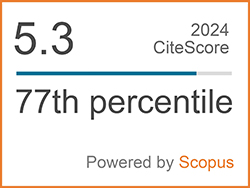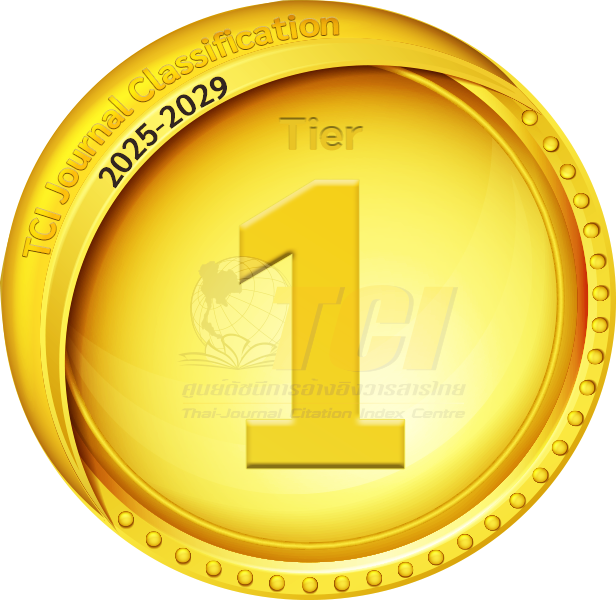Sustainable Production of Vanillin from Vanillyl Alcohol, a Model Compound of Lignocellulosic Biomass Conversion, via Selective Heterogeneous Catalysis
Abstract
Keywords
[1] K. Wang and J. W. Tester, “Sustainable management of unavoidable biomass wastes,” Green Energy and Resources, vol. 1, no. 1, Mar 2023, Art. no. 100005, doi: 10.1016/j.gerr.2023. 100005.
[2] J. Zakzeski, P. C. Bruijnincx, A. L. Jongerius, and B. M. Weckhuysen, “The catalytic valorization of lignin for the production of renewable chemicals,” Chemical reviews, vol. 110, no. 6, pp. 3552–3599, Mar. 2010, doi. 10.1021/cr900354u.
[3] S. Areeya, E. J. Panakkal, M. Sriariyanun, T. Kangsadan, A. Tawai, S. Amornraksa, U. W. Hartley, and P. Yasurin, “A review on chemical pretreatment of lignocellulosic biomass for the production of bioproducts: Mechanisms, challenges and applications,” Applied Science and Engineering Progress, vol. 16, no. 3, pp. 6767, 2023, doi: 10.14416/j.asep.2023.02.008.
[4] M. Oregui-Bengoechea, I. Agirre, A. Iriondo, A. Lopez-Urionabarrenechea, J. M. Requies, I. Agirrezabal-Telleria, K. Bizkarra, V. L. Barrio, and J. F. Cambra, “Topics in current chemistry collections,” in Lignin Chemistry, L. Serrano, R. Luque, and B. F. Sels, Eds. Berlin: Springer, pp. 197–271, 2020.
[5] R. Behling, S. Valange, and G. Chatel, “Heterogeneous catalytic oxidation for lignin valorization into valuable chemicals: What results? What limitations? What trends?,” Green Chemistry, vol. 18, no. 7, pp. 1839–1854, Jan. 2016, doi: 10.1039/C5GC03061G.
[6] M. N. F. Norrrahim, R. A. Ilyas, N. M. Nurazzi, M. S. A. Rani, M. S. N. Atikah, and S. S. Shazleen, “Chemical pretreatment of lignocellulosic biomass for the production of bioproducts: An overview,” Applied Science and Engineering Progress, vol. 14, no. 4, pp. 588–605, 2021, doi: 10.14416/j.asep.2021.07.004.
[7] S. Ali, A. Rani, M. A. Dar, M. M. Qaisrani, M. Noman, K. Yoganathan, M. Asad, A. Berhanu, M. Barwant, and D. Zhu, “Recent advances in characterization and valorization of lignin and its value-added products: Challenges and future perspectives,” Biomass, vol. 4, no. 3, pp. 947–977, Sep. 2024, doi: 10.3390/biomass4030053.
[8] R. Rao and G. A. Ravishankar, “Vanilla flavour: production by conventional and biotechnological routes,” Journal of the Science of Food and Agriculture, vol. 80, no. 3, pp. 289–304, Jul. 2000, doi: 10.1002/1097-0010(200002)80:3<289:: AID-JSFA543>3.0.CO;2-2.
[9] G. A. Martău, L. F. Călinoiu, and D. C. Vodnar, “Bio-vanillin: Towards a sustainable industrial production,” Trends in Food Science & Technology, vol. 109, pp. 579–592, Mar. 2021, doi: 10.1016/j.tifs.2021.01.059.
[10] M. Fache, B. Boutevin, and S. Caillol, “Vanillin production from lignin and its use as a renewable chemical,” ACS Sustainable Chemistry & Engineering, vol. 4, no. 1, pp. 35–46, Dec. 2016, doi: 10.1021/acssuschemeng.5b01344.
[11] M. Wu, J. H. Pang, P. P. Song, J. J. Peng, F. Xu, Q. Li, and X. M. Zhang, “Visible light-driven oxidation of vanillyl alcohol in air with Au-Pd bimetallic nanoparticles on phosphorylated hydrotalcite,” New Journal of Chemistry, vol. 43, no. 4, pp. 1964–1971, Jan. 2019, doi: 10.1039/ C8NJ05477K.
[12] M. Fache, E. Darroman, V. Besse, R. Auvergne, S. Caillol, and B. Boutevin, “Vanillin, a promising biobased building-block for monomer synthesis,” Green Chemistry, vol. 16, no. 4, pp. 1987–1998, Feb. 2014, doi: 10.1039/C3GC42613K.
[13] G. V. Research. “Vanillin market size & trends.” grandviewresearch.com. https://www.grandviewresearch.com/industry-analysis/vanillin-market (accessed Feb. 12, 2025).
[14] Y. Liu, L. Sun, Y. X. Huo, and S. Guo, “Strategies for improving the production of bio-based vanillin,” Microbial Cell Factories, vol. 22, no. 147 pp. 1–11, Aug. 2023, doi: 10.1186/s12934-023-02144-9.
[15] R. J. A. Gosselink, “Lignin as a renewable aromatic resource for the chemical industry,” Ph.D. thesis, Wageningen University, Netherlands, 2011.
[16] M. M. Bomgardner. “The problem with vanilla,” Chemical & Engineering News, vol. 94, no. 36, pp. 38–42, Sep. 2016.
[17] A. Jha and C. V. Rode, “Highly selective liquid-phase aerobic oxidation of vanillyl alcohol to vanillin on cobalt oxide (Co3O4) nanoparticles,” New Journal of Chemistry, vol. 37, no. 9, pp. 2669–2674. Jun. 2013, doi: 10.1039/C3NJ00508A.
[18] R. Ciriminna, A. Fidalgo, F. Meneguzzo, F. Parrino, L. M. Ilharco, and M. Pagliaro, “Vanillin: The case for greener production driven by sustainability megatrend,” Chemistry Open, vol. 8, no. 6, pp. 660–667, May. 2019, doi: 10.1002/open.201900083.
[19] W. Hou, N. A. Dehm, and R. W. J. Scott, “Alcohol oxidations in aqueous solutions using Au, Pd, and bimetallic AuPd nanoparticle catalysts,” Journal of Catalysis, vol. 253, no. 1, pp. 22–27, Jan. 2008, doi: 10.1016/j.jcat.2007. 10.025.
[20] J.-Y. Lin, H.-K. Lai, and K.-Y. A. Lin, “Rapid microwave-hydrothermal conversion of lignin model compounds to value‑added products via catalytic oxidation using metal organic frameworks,” Chemical Paper, vol. 72, pp. 2315–2325, Mar. 2018, doi: 10.1007/s11696-018-0452-4.
[21] X. Wu, S. Guo, and J. Zhang, “Selective oxidation of veratryl alcohol with composites of Au nanoparticles and graphene quantum dots as catalysts,” Chemical Communications, vol. 51, no. 29, pp. 6318–6321, Apr. 2015, doi: 10.1039/ c5cc00061k.
[22] G. F. Santori, M. L. Casella, G. J. Siri, H. R. Adúriz, and O. A. Ferretti, “Hydrogenation of crotonaldehyde on Pt/SiO2 catalysts modified with tin added via surface organometallic chemistry on metals techniques,” Applied Catalysis A: General, vol. 197, no. 1, pp. 141–149, Apr. 2000, doi: 10.1016/S0926-860X(99) 00548-7.
[23] M. Thommes, K. Kaneko, A. V. Neimark, J. P. Olivier, F. Rodríguez-Reinoso, J. Rouquerol, and K. S. W. Sing, “Physisorption of gases, with special reference to the evaluation of surface area and pore size distribution,” Pure and Applied Chemistry, vol. 87, no. 9–10, pp. 1051–1069, 2015, doi: 10.1515/pac-2014-1117.
[24] W. S. Lamme, O. van der Heijden, N. A. Krans, E. Nöllen, N. Mager, S. Hermans, J. Zečević, and K. P. de Jong, “Origin and prevention of broad particle size distributions in carbon-supported palladium catalysts prepared by liquid-phase reduction,” Journal of Catalysis, vol. 375, pp. 448–455, Jul. 2019, doi: 10.1016/j.jcat.2019.06. 034.
[25] W. S. Lamme, J. Zečević, and K. P. de Jong, “Influence of metal deposition and activation method on the structure and performance of carbon nanotube supported palladium catalysts,” ChemCatChem, vol. 10, no. 7, pp. 1552–1555, Jan. 2018, doi 10.1002/cctc.201701991.
[26] J. Yang, V. Tschamber, D. Habermacher, F. Garin, and P. Gilot, “Effect of sintering on the catalytic activity of a Pt based catalyst for CO oxidation: Experiments and modelling,” Applied Catalysis B: Environmental, vol. 83, no. 3–4, pp. 229–239, Sep. 2008, doi: 10.1016/j.apcatb.2008. 02.018.
[27] G. Bergeret and P. Gallezot, “Particle size and dispersion measurements,” in Handbook of Heterogeneous Catalysis, 2nd ed., vol. 2, G. Erltl, H. Knözinger, F. Schüth, and J. Weitkamp, Eds. Weinheim, Germany: Wiley-VCH, pp. 738–765, 2008, doi. 10.1002/9783527610044. hetcat0038.
[28] K. Pattamakomsan, E. Ehret, F. Morfin, P. Gélin, Y. Jugnet, S. Prakash, J. C. Bertolini, J. Panpranot, and F. J. Cadete Santos Aires, “Selective hydrogenation of 1,3-butadiene over Pd and Pd–Sn catalysts supported on different phases of alumina,” Catalysis Today, vol. 164, no. 1, pp. 28–33, Apr. 2011, doi: 10.1016/ j.cattod.2010.10.013.
[29] K. Y. A. Lin, H. K. Lai, and Z. Y. Chen, “Selective generation of vanillin from catalytic oxidation of a lignin model compound using ZIF-derived carbon-supported cobalt nanocomposite,” Journal of the Taiwan Institute of Chemical Engineers, vol. 78, pp. 337–343, Sep. 2017, doi: 10.1016/j.jtice.2017.06.029.
[30] R. Behling, G. Chatel, and S. Valange, “Sonochemical oxidation of vanillyl alcohol to vanillin in the presence of a cobalt oxide catalyst under mild conditions,” Ultrasonics Sonochemistry, vol. 36, pp. 27–35, May 2017, doi: 10.1016/j.ultsonch.2016.11.015.
[31] P. Elamathi, M. K. Kolli, and G. Chandrasekar, “Catalytic oxidation of vanillyl alcohol using FeMCM-41 nanoporous tubular reactor,” International Journal of Nanoscience, vol. 17, no. 01–02, 2018, Art. no. 1760010, doi: 10.1142/ S0219581X17600109.
[32] A. Jha, D. Mhamane, A. Suryawanshi, S. M. Joshi, P. Shaikh, N. Biradar, S. Ogale, and C.V. Rode, “Triple nanocomposites of CoMn2O4, Co3O4 and reduced graphene oxide for oxidation of aromatic alcohols,” Catalysis Science & Technology, vol. 4, no. 6, pp. 1771–1778, Mar. 2014, doi: 10.1039/C3CY01025B.
[33] M. Shilpy, M. A. Ehsan, T. H. Ali, S. B. Abd Hamid, and M. E. Ali, “Performance of cobalt titanate towards H2O2 based catalytic oxidation of lignin model compound,” RSC advances, vol. 5, no. 97, pp. 79644–79653, Sep. 2015, doi: 10.1039/C5RA14227J.
[34] F. Saberi, D. Rodríguez-Padrón, E. Doustkhah, S. Ostovar, A. Franco, H. R. Shaterian, and R. Luque, “Mechanochemically modified aluminosilicates for efficient oxidation of vanillyl alcohol,” Catalysis Communications, vol. 118, pp. 65–69, Jan. 2019, doi: 10.1016/ j.catcom.2018.09.017.
[35] B. Rahmanivahid, M. Pinilla-de Dios, M. Haghighi, and R. Luque “Mechanochemical synthesis of CuO/MgAl2O4 and MgFe2O4 spinels for vanillin production from isoeugenol and vanillyl alcohol,” Molecules, vol. 24, no. 14, Jul. 2019, Art. no. 2597, doi: 10.3390/molecules 24142597.
[36] S. Saha and S. B. Abd Hamid, “CuZrO3 nanoparticles catalyst in aerobic oxidation of vanillyl alcohol,” RSC advances, vol. 7, no. 16, pp. 9914–9925, Jan 2017, doi: 10.1039/ c6ra26370d.
[37] M. Cui, L. Dong, Z. Shen, T. Guo, W. Zhao, C. L.iang, X. Liu, D. Wang, F. Wang, Z. Jiang, and S. Fu, “Preparation of porous carbon supported Co element doping spinel copper ferrite for the catalytic oxidation of vanillyl alcohol,” Applied Catalysis A: General, vol. 664, Aug. 2023, Art. 119325, doi: 10.1016/j.apcata.2023.119325.
[38] S. Nazeer, S. Palli, Y. Kamma, M. K. Palnati, B. M. Reddy, and T. Venkateshwar Rao, “Mesoporous copper-cerium mixed oxide catalysts for aerobic oxidation of vanillyl alcohol,” Catalysts, vol. 13, no. 7, Jun 2023, Art. 1058, doi: 10.3390/catal13071058.
[39] S. Palli, Y. Kamma, S. Nazeer, B. M. Reddy, and T. Venkateshwar Rao. “Oxidation of vanillyl alcohol to vanillin over nanostructured cerium–iron mixed oxide catalyst with molecular oxygen,” Research on Chemical Intermediates, vol. 48, no 11, pp. 4579–4599, Sep. 2022, doi: 10.1007/s11164-022-04827-1.
[40] C. S. Hinde, D. Ansovini, P. P. Wells, G. Collins, S. V. Aswegen, J. D. Holmes, T. S. A. Hor, and R. Raja, “Elucidating structure–property relationships in the design of metal nanoparticle catalysts for the activation of molecular oxygen,” ACS Catalysis, vol. 5, no. 6, pp. 3807–3816, May. 2015, doi: 10.1021/acscatal.5b00481.
[41] W. Sun, S. Wu, Y. Lu, Y. Wang, Q. Cao, and W. Fang, “Effective control of particle size and electron density of Pd/C and Sn-Pd/C nanocatalysts for vanillin production via base-free oxidation,” ACS Catalysis, vol. 10, no. 14, pp. 7699–7709, Jul. 2020, doi: 10.1021/acscatal. 0c01849.
[42] A. Al-Hunaiti, A. Ghazzy, N. Sweidan, Q. Mohaidat, I. Bsoul, S. Mahmood, and T. Hussein, “Nano-Magnetic NiFe2O4 and its photocatalytic oxidation of vanillyl alcohol—synthesis, characterization, and application in the valorization of lignin,” Nanomaterials, vol. 11, no. 4, Apr. 2021, Art. no. 1010, doi: 10.3390/ nano11041010.
[43] C. S. McCallum, W. Wang, W. J. Doran, W. G. Forsythe, M. D. Garrett, C. Hardacre, J. J. Leahy, K. Morgan, D.S. Shin, and G.N. Sheldrake, “Life cycle thinking case study for catalytic wet air oxidation of lignin in bamboo biomass for vanillin production,” Green Chemistry, vol. 23, no. 4, pp. 1847–1860, Feb. 2021, doi: 10.1039/ D0GC03685D.
[44] L. J. Csányi, L. Nagy, M. Galbács, and I. Horváth, “Alkali-Induced generation of superoxide and hydroxyl radicals from aqueous hydrogen peroxide solution,” Zeitschrift für Physikalische Chemie, vol. 138, no. 1, pp. 107–116, Jul. 1983, doi: 10.1524/zpch.1983.138.1.107.
[45] H. Wang, L. Jiao, L. Zheng, Q. Fang, Y. Qin, X. Luo, X. Wei, L. Hu, W. Gu, J. Wen, and C. Zhu, “PdBi single-atom alloy aerogels for efficient ethanol oxidation,” Advanced Functional Materials, vol. 31, no. 38, Jul. 2021, Art. 2103465, doi: 10.1002/adfm.202103465.
[46] N. Xaba, R. M. Modibedi, M. K. Mathe, and L. E. Khotseng, “Pd, PdSn, PdBi, and PdBiSn nanostructured thin films for the electro-oxidation of ethanol in alkaline media,” Electrocatalysis, vol. 10, no. 11, pp. 332–341, Feb. 2019, doi: 10.1007/s12678-019-0511-9.
[47] M. L. Faroppa, “Valorización de biomasa. Desarrollo de catalizadores heterogeneos para la oxidación del glicerol crudo obtenido en el proceso de producción de biodiesel,” Ph.D. thesis, Universidad Nacional del Noroeste de la Provincia de Buenos Aires, Argentina, 2023.
[48] M. L. Faroppa, M. E. Chiosso, J. J. Musci, M. A. Ocsachoque, A. B. Merlo, and M. L. Casella, “Oxidation of glycerol in base-free aqueous solution using carbon-supported Pt and PtSn catalyst,” Catalysts, vol. 13, Jul. 2023, Art. no. 1071, doi: 10.3390/catal13071071.
DOI: 10.14416/j.asep.2025.06.005
Refbacks
- There are currently no refbacks.
 Applied Science and Engineering Progress
Applied Science and Engineering Progress







